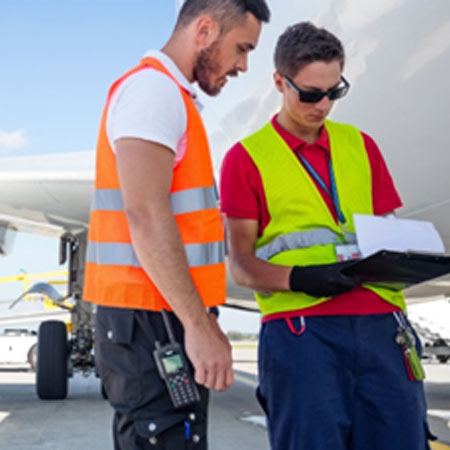
The first IATA CBTA Center provider in India for DG training.
Dangerous Goods Regulations
Home / Courses / Dangerous Goods Regulations

| Well defined function | Task lists |
|---|---|
| 7.1 | Personnel Responsible for Preparing Dangerous Goods Consignments |
| 7.2 | Personnel Responsible for Processing or Accepting Goods Presented as General Cargo |
| 7.3 | Personnel Responsible for Processing Dangerous Goods Consignments |
| 7.3 | Personnel Responsible for Accepting Dangerous Goods Consignments |
| 7.4 | Personnel Responsible for Handling Cargo in a Warehouse, Loading and Unloading Unit Load Devices, and Loading and Unloading of Aircraft Cargo Compartments |
| 7.5 | Personnel Responsible for Accepting Passenger and Crew Baggage, Managing Aircraft Boarding Areas, and other Functions involving Direct Passenger Contact at an Airport |
| 7.6 | Personnel Responsible for the Planning of Aircraft Loading |
| 7.7 | Flight Crew |
| 7.8 | Flight Operations Officers and Flight Dispatchers |
| 7.9 | Cabin Crew |
| 7.10 | Personnel Responsible for the Screening of Passengers and Crew and their Baggage, Cargo, and Mail |

Function 7.1
Personnel preparing dangerous goods receive tailored training focused on specific classes and tasks. Their objectives include ensuring compliance, proper classification, packaging, documentation, risk assessment, and effective communication for safe transport.

Function 7.2
Staff tasked with processing or accepting goods labeled as general cargo must be familiar with dangerous goods regulations to identify such consignments. Training and assessment for those handling general cargo may focus on specific classes, divisions, or UN numbers eligible for transportation.

Function 7.3
Personnel tasked with processing or accepting dangerous goods consignments must possess the necessary skills to verify and validate compliance with air transport regulations and ensure the goods' fitness for transport. These personnel may be associated with freight forwarders, ground handling agents, or operators. Adequate knowledge is essential for competent task performance, and the provided extract outlines the specific tasks and sub-task's responsibilities.

Function 7.4
Personnel responsible for warehouse cargo handling, unit load device operations, and loading/unloading passenger baggage and aircraft cargo compartments require training and assessment for specific tasks to perform their assignments.

Function 7.5
Personnel entrusted with responsibilities such as accepting passenger and crew baggage, managing aircraft boarding areas, and engaging in direct passenger contact at an airport need training and assessment to effectively ensure passenger safety by preventing the transportation of concealed dangerous goods in passengers' baggage.

Function 7.6
Personnel responsible for planning aircraft loading related to dangerous goods perform critical functions such as assessing and coordinating the placement of hazardous materials within the aircraft, ensuring compliance with relevant regulations, and implementing safety measures to prevent potential risks during loading and unloading operations.

Function 7.7
Flight crew handling dangerous goods ensure proper documentation, secure stowage, and communication with ground personnel. They vigilantly monitor and respond to issues during the flight, following regulations to guarantee the safety of the aircraft and occupants.

Function 7.8
Flight operations officers and dispatchers overseeing dangerous goods coordinate documentation, secure loading, and communicate crucial information. They ensure compliance with regulations, contributing to the safe transport of hazardous materials during flights.

Function 7.9
Cabin crew members responsible for handling dangerous goods play a crucial role in ensuring the safety of passengers and the aircraft. Their duties involve inspecting, documenting, and safely stowing hazardous materials on board.

Function 7.10
Personnel screen passengers, crew, and cargo for dangerous goods compliance, ensuring safe air travel by detecting and mitigating potential risks.







SPW024
Shippers and persons undertaking the responsibilities of shippers, including operator’s staff acting as shippers, operator’s staff preparing dangerous goods as Company Materials (COMAT)

SPW025
Packers

SPW026
Staff of Freight Forwarders involved in processing dangerous goods.

SPW027
Staff of Freight Forwarders involved in processing cargo or mail (other than dangerous goods)

SPW028
Staff of Freight Forwarders involved in handling, storage and loading of cargo or mail.

SPW029
Operators and ground handling agent’s staff accepting dangerous goods.

SPW030
Operators and ground handling agent’s staff accepting cargo or mail (other than dangerous goods)

SPW031
Operators and ground handling agent’s staff involved in the handling, storage and loading of cargo or mail and baggage

SPW032
Passenger handling staff

SPW033
Flight crew members, loadmasters, load planners and flight operations officers/flight dispatchers

SPW034
Crew members (other than flight crew members)

SPW035
Security staff who deal with the screening of passengers and crew and their baggage and cargo or mail, e.g. security screeners, their supervisors and staff implementing security procedures.

SPW036
Operator’s and ground handling agent’s staff accepting cargo or mail (other than dangerous goods)

SPW037
Operator’s and ground handling agent’s staff involved in the handling, storage and loading of cargo or mail and baggage.

SPW038
Passenger Handling Staff

SPW039
Flight Crew members, Loadmasters, load planners and flight operations officers/flight dispatchers

SPW040
Crew members (other than flight crew members)

SPW041
Staff of designated postal operators involved in accepting mail containing dangerous goods

SPW042
Staff of designated postal operators involved in processing mail (other than dangerous goods)

SPW043
Staff of designated postal operators involved in the handling, storage and loading of mail